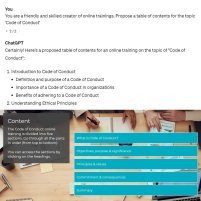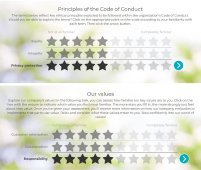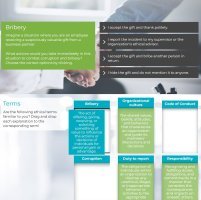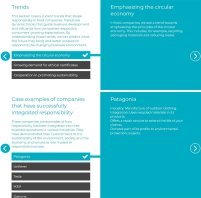Apprix’s content team members Anni, Henni, and Maija tested generative artificial intelligence in the production of eLearning content. Each created their own online training, where content was generated solely with the help of AI. Read the interview to discover their thoughts on using AI in eLearning content production and how they plan to utilize AI in the future.
How can artificial intelligence be utilized in eLearning content production?
Anni: Artificial intelligence is particularly beneficial when you are unsure about the type of online training to create on a specific topic, or when structuring content feels challenging. In such cases, it’s advisable to ask the AI what constitutes a good eLearning related to the topic at hand and start forming content based on its suggestions. It’s useful to inform the AI that the online training can include various tasks and information can be presented in different formats, so it can propose suitable places and topics for these elements as well. Additionally, AI can be helpful when coming up with tasks for the training seems difficult.
Henni: AI is a helpful companion in content production in many ways. It is adept at both quickly brainstorming ideas and developing larger concepts. For example, you can overcome the fear of a “blank page” by asking the AI for ideas on the topic at hand. Once you have a few sentences ready, the barrier to producing text is already lowered. Another great way to use it is outsourcing the creation of various response texts or options to AI. You can request a statement for a true/false task, for example, or why not ask AI to create an entire case task?
Maija: Artificial intelligence can be beneficial both in ideation and when the work is already well underway. In ideation, AI can be asked, for example, to provide a table of contents or structure on a topic, allowing one to see the overall picture at a headline level and decide on the implementation of the segmentation. During the content production process, AI can be requested, for instance, to explain individual topics, clarify terms, or generate tasks related to the subject. Artificial intelligence also provides good explanatory and definition texts, which are useful to use, for example, as summarizing informational texts at the end of tasks.

What aspects did you find artificial intelligence particularly helpful in?
Henni: In my work, I’ve noticed that artificial intelligence excels when I need new ideas or perspectives. Sometimes, educational material can be quite limited, so AI can be used to gather additional material. For example, I’ve asked AI to provide examples of successful sustainability actions by other companies and incorporated this information into relevant parts of the training. Additionally, AI was a great help in coming up with tasks. This requires a bit more guidance from the user, and tasks often can’t be directly copied into the training. However, I found the effort required to be minimal considering how quickly the entirety of task material was completed.
Maija: The greatest benefit of artificial intelligence in my own project was in content generation. AI produces a lot of text, so both for informational pages and tasks, I got a good basis from the text generated by AI. I fact-checked elsewhere, and if things matched up, it was quick and easy to create content by trimming, modifying, and rearranging the text generated by artificial intelligence.
Anni: I found AI particularly useful in brainstorming case tasks, as AI was very good at creating realistic situations based on given topics and forming problems with solution options. Of course, you shouldn’t necessarily use AI’s outputs as they are, and AI should be used more as an inspiration. Additionally, I was surprised at how good the structural plans AI produced were; they provided a great foundation to build the online course upon.

What challenges can arise with artificial intelligence?
Maija: Artificial intelligence isn’t always correct, so fact-checking is necessary. Sometimes AI lacks consistency, and on some days, it may produce naive text. Therefore, AI can seem to be in different moods on different days, generating better or worse text. It’s also important to remember that if using open AI (and not an organization’s own closed system), caution should be exercised with trade secrets. AI is considered a third party. However, these challenges don’t mean that AI shouldn’t be utilized. When used carefully, it can be a great help.
Anni: In addition to the examples Maija provided, I’ve noticed that artificial intelligence often struggles to steer the conversation back on track if it has veered off course. If the AI starts generating naive, patronizing, or otherwise silly answer options for tasks, it’s no longer helpful to try to prompt it by modifying the prompts. Therefore, it’s important to clearly communicate to the AI what kind of text is expected from the beginning and to start a completely new conversation with modified prompts if the previous one doesn’t produce satisfactory results.
Henni: It’s important to be very careful with artificial intelligence to ensure that incorrect information doesn’t accidentally find its way into the training. You can never fully trust that the information provided by AI is correct, so use your own judgment here. AI can also lead your content astray if you’re not careful. It tends to interpret things in the way it has learned previously, so it’s up to the user to correct the direction if the main point starts to fade. Especially at the beginning, you may find yourself tweaking prompts frustratingly often, but as you gain experience, things will start to flow, and you’ll soon learn to speak the same language as the AI. The AI quickly starts to recycle the same content in slightly different wordings. Therefore, the content producer must be careful to maintain the quality of the training.

Can artificial intelligence replace a human as a content producer?
Anni: While artificial intelligence can be a helpful tool, it doesn’t compare to a human in content production. AI may be good at generating generic texts and simple online training content, but it’s important to remember that its output is always based on probabilities rather than thinking. That’s why a human is always needed, and at least for now, I’m not worried that AI could replace me.
Maija: In my opinion, artificial intelligence cannot replace a content producer. Texts generated by AI almost always need editing both in terms of language and content. In addition to the details of the text, humans are needed to understand the overall picture and even to change the structure. Sometimes, contents also require nuances (such as carefully crafted humor) that a machine cannot execute in the same way as a human. Furthermore, content may need to be modified later; in such cases, AI can be tried, but I wouldn’t entrust such editing work to it myself. Machines can be taught a lot, but in any case, it must be a human who evaluates the quality, acceptability, and usability of online training content.
Henni: In content production, artificial intelligence still needs humans much more than humans need AI. As mentioned earlier, AI interprets things in its own way and requires continuous guidance from humans. It’s also the content producer’s responsibility to carefully review all the material produced by AI. Additionally, AI currently can’t create content tailored to a specific company. Within companies, there is a vast amount of information about various practices, processes, and guidelines that apply only to that specific company and possibly to a specific branch. Our clients’ trainings largely focus on these themes, and this is where AI can’t fully replace the content producer. As long as these challenges persist for AI, I’m not afraid that my job as a content producer is in danger.

To what extent do you plan to use artificial intelligence in the future?
Maija: I don’t use artificial intelligence systematically, but there are situations where I like to utilize it. If there’s no existing material such as a presentation, quality handbook, presentation outline, etc., I definitely try to see what AI has to say on the topic. I would also seek help from AI when the subject is unfamiliar or new to me. Additionally, artificial intelligence is handy for explaining terms, so I will continue to use it for that purpose.
Anni: I usually utilize artificial intelligence when I encounter writer’s block or feel stuck with some content. I wouldn’t solely produce entire online courses using AI anymore, even though testing it was fun and educational. However, I will definitely continue to use AI for brainstorming and, for example, writing summaries. Additionally, when it comes to translations, I like using AI when I understand both working languages myself, but when translating into a completely foreign language, I wouldn’t blindly trust AI.
Henni: I work a lot with company-specific materials, so the use of AI is inherently limited. Therefore, I mainly use AI to expand existing materials or to develop even better task content. Sometimes, I may also ask AI to brainstorm with me, much like I would discuss with a colleague.

Top 5 tips for using artificial intelligence from Apprix’s content team:
- Practice and learn. Utilizing artificial intelligence improves with practice.
- Human input is always necessary. Review what the AI has suggested and tailor the text appropriately in terms of language and content.
- Try different ways of prompting. The AI’s response depends a lot on the tone and detail of the prompt.
- Ask the AI to ask you questions. It can be difficult to determine what should be included in the prompts and what information to provide to the AI. This way, the AI requests the information it needs and provides better suggestions.
- Don’t be afraid of mistakes. Sometimes, the AI doesn’t understand at all what’s going on, but some parts of its “thoughts” can spark new insights in you.
Author
Compiled by:
Anni Immonen
Interviewees:
Anni Immonen
Henni Turkia-Tiensuu
Maija Peltola